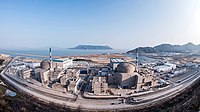
Photo from wikipedia
Solid-state electrolytes (SSEs) are promising candidates to circumvent flammability concerns of liquid electrolytes. However, enhancing energy densities by thinning SSE layers and enabling scalable coating processes remain challenging. While previous… Click to show full abstract
Solid-state electrolytes (SSEs) are promising candidates to circumvent flammability concerns of liquid electrolytes. However, enhancing energy densities by thinning SSE layers and enabling scalable coating processes remain challenging. While previous studies have addressed thin and flexible SSEs, mainly ionic conductivity was considered for performance evaluation, and no systematic research on the effects of manufacturing conditions on the quality of SSE films was performed. Here, both uniformity and ionic conductivity are considered for evaluating the SSE films under the guidance of machine learning (ML). Three algorithms, principal component analysis, K-means clustering, and support vector machine, are employed to decipher the interdependencies between manufacturing conditions and film performance. Guided by ML, a 40 μm SSE film with high ionic conductivity and good uniformity is used to construct a LiNi0.8Co0.1Mn0.1O2 || Li6PS5Cl || LiIn cell demonstrating 100 cycles. This study presents an efficient ML-assisted approach to optimize scalable production of high-quality SSE films. Li-ion batteries (LIBs) are currently the predominant energy storage technology widely used in portable electronic devices, electric vehicles, and grid energy storage. Conventional LIBs employ liquid electrolytes containing flammable organic solvents, making them susceptible to leakage and potential flammability concerns. One of the solutions to circumvent this is to replace liquid electrolytes with inorganic solid-state electrolytes (SSEs) in order to produce all-solid-state batteries (ASSBs) with improved safety and wider operating temperature ranges. As a result, significant efforts have been devoted to developing various SSEs, some of which have exhibited ionic conductivities reaching 10−2 S cm−1 at room temperature, close to those of liquid electrolytes. However, because of mechanical property limitations and under-developed manufacturing processes for inorganic SSEs, cells with pellet-type SSE layers thicker than 200 μm are still predominantly employed in ASSB research. Unlike cathode and anode materials, electrolytes do not store energy, and thus, using thick SSE layer limits energy density. To compete with conventional LIBs, it is therefore crucial to develop new fabrication processes that enable the manufacturing of cells using film-type SSE layers with reduced thicknesses, ideally 25−50 μm, to reach high energy density, while still maintaining ideal mechanical properties. These fabrication techniques must also be compatible with existing manufacturing methods, such as conventional doctor-blade or roll-to-roll coating processes. The most common way to address these aforementioned issues is to include polymer binders in the SSE composite, as they provide an added flexibility to the fabricated SSE films to compensate for mechanical weakness of pellet-type SSEs. Indeed, mechanical failures of SSEs in ASSBs are detrimental to battery performance. This approach also enables a scalable doctor-blade or roll-to-roll solution process. Film-type SSEs, combining sulfide inorganic SSEs with polymer binders and fabricated with doctor-blade, have been reported in the literature (Table 1) with ionic conductivities ranging between 10−5 and 10−3 S cm−1. This wide conductivity variation can be attributed in part to the usage of different polymer binders and SSEs. However, even when similar polymer binders and Received: February 14, 2021 Accepted: March 26, 2021 Leter http://pubs.acs.org/journal/aelccp © XXXX American Chemical Society 1639 https://doi.org/10.1021/acsenergylett.1c00332 ACS Energy Lett. 2021, 6, 1639−1648 D ow nl oa de d vi a U N IV O F C A L IF O R N IA S A N D IE G O o n A pr il 1, 2 02 1 at 2 2: 55 :5 3 (U T C ). Se e ht tp s: //p ub s. ac s. or g/ sh ar in gg ui de lin es f or o pt io ns o n ho w to le gi tim at el y sh ar e pu bl is he d ar tic le s.
Journal Title: ACS energy letters
Year Published: 2021
Link to full text (if available)
Share on Social Media: Sign Up to like & get
recommendations!